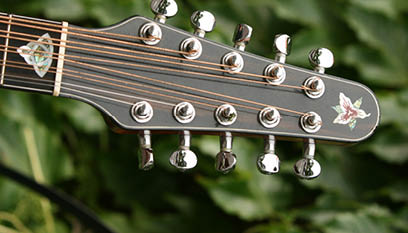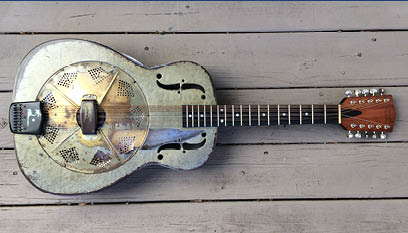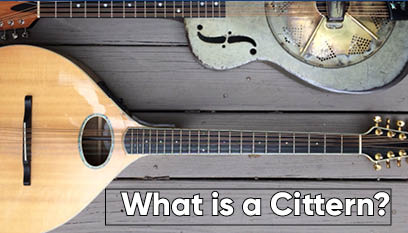
A cittern is “kind of a mandolin on steroids. It’s a lute-like instrument similar to an Irish bouzouki but with 10 strings instead of 8 and a little bigger body,” according to veteran cittern player Carol Coronis.
Citterns first came to my attention while I was taking photos for a local art paper, one of the musicians (Coronis) pulled out an instrument I couldn’t place. It looked like a large mandolin with a long neck. It had double strings like a mandolin or a 12-string guitar, but it was clearly neither of them. When I asked what it was, she replied that it was a cittern. I had never seen one before and I needed to know more about it.
Citterns are based on a 16th-century guitar design, but they are very different from those Renaissance- and Baroque-era instruments. Those had the pear-shaped body with a neck that was asymmetrical and thicker under the treble strings; the head was usually curved and sometimes the neck was shortened.
According to Coronis, “In 1973 musician and luthier Stefan Sobel made probably what was the first modern cittern and gave it that name because he liked the sound of it. It does fit. Today’s citterns are bigger and more like a mandolin in shape. It’s related to the Portuguese guitarra, which was actually Sobel’s inspiration for his cittern.”
Coronis was kind enough to take some time and sit down with me to answer all of my questions on citterns.
SGT:What kinds of music are citterns usually used for?
Coronis: Any. From the 1970s, they were used primarily in Celtic music. I play that as well as a lot of rock, roots, and Greek music on it; its predecessor can also be said to have been the Greek bouzouki, as this instrument was introduced to Irish musicians Johnny Moynihan and the late Alec Finn in 1964 via a man named Tony French. This instrument had a round back which is inconvenient to play, so it was flattened and made wider–this also gave it a more bass sound. That was a good thing as I have a couple of my dad’s Greek bouzoukis and they are a royal pain to hold. Anyway, whatever you hear in your head, you can make it come to life with a cittern.
SGT: Is there a specific way citterns are usually used in music? Meaning do they tend to be a lead or rhythm instrument or are they flexible like a guitar is?
Coronis: They’re great for both solo and accompaniment. Since they are in the range of a guitar, they are an incredible vehicle for rhythm playing for a vocalist as they are tuned modally. Then they can take the lead dramatically. I like the low D string on mine; it’s such a deep bass sound that provides an exceptional bottom to any band.
SGT: When did you start playing cittern and what got you started?
Coronis: In 2000. I loved The Ceili Show with Roland Goodbody hosting and I was amazed by the musicianship and the sound in the theme tune for the show, Paddy O’Brien’s/Arthur Darley’s/ Scatter the Mud by cittern player Gerald Trimble. I called Roland out of the blue during the show to find out about the tune and he was wonderful—he gave me the info I needed to get ahold of the 1983 CD release First Flight. I did, and I started to learn the tunes. I’d played guitar since I was 13 and although the fingering is totally different, it wasn’t that tricky for me to learn. I let my ear tell me what to play rather than think about it analytically. I like to play in different tunings as well because your ear hears different things. When I started hosting The Ceili Show myself years later, I kept the theme tune– it’s still our tune for today with Bob Knight and myself hosting the show on alternate Sundays. I never got tired of hearing it. And the first tune of the set is about the trickiest tune I’ve ever played but eventually I mastered it. It’s an instrument you just want to keep playing.
SGT: Who are some of the best-known cittern players?
Coronis: Of course, Gerald Trimble, from Kansas City. And locally, from Maine, David Surette and Hugh McGuinness.
Then Dan Beimborn, Robin Bullock, Roger Landis, Paddy Smith, Chris O’Shea, Doc Rossi, Mark Fitzsimons, Brian McNeill, Joseph Sobol, John Peekstok—and I’m sure there are others that I’m spacing.
Barbara Shultz, who may not be famous, is the only female cittern player I can find….. What’s up with that? I know there have to be more.

SGT: Who made your citterns?
SGT: Bob Abrams, musician and luthier from Nottingham, NH made my two Trilliums. My first cittern, Aspasia, is a 22.5 inch scale and has a rich deep sound; it’s 20 years old and looks and sounds beautiful in spite of the way I beat on it over the years. The second one, Athena, is a 25-inch scale and has a lighter sound, more like a bouzouki. She’s going on 12 years and also rocks her heart out. That they both sound better than ever and are still in the excellent condition I received them is a testament to Bob’s amazing workmanship.
On a side note, Irish multi-instrumentalists John Doyle and Andy Irvine have mandolas made by Bob; the instrument looks like a mandolin and is tuned a 5th below a mandolin like a viola is tuned a fifth below a violin. I’m sure they could rock a cittern.
SGT: Are there companies that mass-produce citterns?
SGT: Not sure… I haven’t found any. P. W. Crump Co. in California makes a variety of fine custom acoustic instruments including citterns, as does Bigleaf Mandolins in Canada. There are a lot of luthiers making this instrument but I’m guessing one would be hard-pressed to come by one that’s been mass-produced. I don’t have the final word on this but I haven’t found a company that mass-produces citterns. I’m thinking most are custom.

SGT: You have a very beautiful cittern which is made from a National guitar body. What is the story of this instrument?
SGT: Yes! My dad got his first guitar when he was about 11 years old and it was a 1935 National steel guitar. His parents ordered him a wooden guitar from Sears and Roebuck—well, when they went to pick it up on the day it was supposed to have arrived, it wasn’t there. For years the store’s policy was that if what you ordered didn’t arrive when they told you it would, they’d give you the next best item they had for what you ordered. And that was the steel National. My dad, Charles Coronis, was an amazingly gifted musician—he played everything but his primary instruments were guitar (jazz and more), mandolin, and Greek bouzouki. But this instrument was his first instrument ever.
I took it to college with me, never realizing the value of it. It survived, but barely. Once I was walking down the street with it and a car pulled up beside me and a man got out and offered me $2000 for it. It wasn’t mine so of course I said no. Good thing. Anyway, soon after, it fell and the neck was damaged. It’d been repaired 3 times but the tuning was never the same. It was sitting under my bed for years when I decided it would rock as a cittern. I have plenty of guitars but only 2 citterns and I thought, why not? My friend Steve Rowley of York, Maine who’s a retired subsea robotics engineer, makes everything from guitars to boats and anything else his mind can think of—he offered to restore the instrument with a new cittern neck. He did so beautifully—he crafted a luscious mahogany neck and a very cool ebony tailpiece complete with a little mother-of-pearl palm tree inlay, the palm tree being National’s signature motif; he eliminated some yucky-looking welding at the bridge—and with a new biscuit and a new cone inside, he even electrified it like my other 2 citterns. Steve gave new life and light to this yummy instrument—it’s so beautiful and ethereal.
SGT: What is the difference between a cittern and a bouzouki?
Coronis: A bouzouki has 8 strings, 4 sets of doubles, and is usually tuned like a mandolin and fiddle: GDAE. A cittern has 10 strings, 5 sets of doubles, and has a bunch of tunings. I usually use DAEAE or DADAD, depending on the range of the song I’m singing and what I want the ear to hear as they are distinctly different tunings. The cittern body is also a little bigger than the bouzouki body. The cittern can get a more bass sound because of the low D string.
However, just to make things interesting—Stefan Sobel would call my 25-inch scale a bouzouki while the 22.5 inch scale instrument is the cittern. But mostly, the 10-stringed instrument is called a cittern in most parts of everywhere.
SGT: Is it common to have multiple cittern players play together in an ensemble or is it like a mandolin or banjo where one is usually all you need?
Coronis: That’s a good question. I’m not sure if there are enough of us in one location to have a cittern jam. But that would be fun! I’ve played both with Dave Surette and Hugh McGuinness but the 3 of us have never played together. What a good idea—to have a cittern convention and get a bunch of us in a room—I think it would be a blast!
Thanks again to Carol Coronis for sharing her vast knowledge of citterns with us! If you’re looking for more information on her music you can check her out at CarolCoronis.com.

